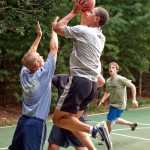The brain behind the game
Top athletes watch and learn from their teams, coaches and opponents

With March Madness right around the corner, basketball-watching season is in full swing. People who play or watch the sport know that the right shot can make or break a game. A swoosh through the hoops may bring the thrill of victory; a backboard bounce may give a team another chance.
Devoted fans aren’t the only ones watching pro basketball players and other athletes. Though top jocks may be well known for using their bodies, scientists have found that athletes’ brains also work hard while playing. Researchers are finding that during critical moments of the game, a player’s brain uses information differently than a fan’s, coach’s or other onlooker’s. These differences can help athletes make crucial decisions at breakneck speeds.
Salvatore Aglioti, a neuroscientist at Sapienza University of Rome, studies how the human brain processes images of the body. He’s interested in the differences and similarities between the real, physical world and the virtual one created and used by the brain to help a person understand his or her surroundings. Aglioti thinks that brain cells called mirror neurons might be particularly important among athletes.
Mirror neurons become active when a person does an action or when a person watches someone else do an action. These neurons behave the same whether you’re brushing your teeth or watching your friend brush her teeth. A basketball player’s mirror neurons fire when he’s playing and when he’s watching someone else play.
Mirror neurons may help a player predict what’s going to happen in a game. When a player’s brain uses mirror neurons to track the actions of an opponent, the player might be able to anticipate his opponent’s next move and quickly respond in the best way.
Aglioti designed a test to see if pro players were better than novices and spectators at anticipating another player’s moves. He showed each group time-lapse photographs of a player shooting, including the ball leaving the player’s hands. He compared the groups’ abilities to predict the success or failure of the shot.
“Compared to novices and scouts, elite athletes were better at predicting the outcome of a shot after watching the body motion of basketball players,” Aglioti told Science News.
A recent study of cricket athletes also showed that expert players take cues from body language to predict how the game will play out. And expert cricket players could better guess where a ball was headed if they were allowed to swing a bat while making their prediction — suggesting that imitating the action helps with anticipation.
Novice cricket players’ predictions did not get better with a bat in hand. The study suggests that an athlete’s ability may rely on a strong connection between the real world and the virtual one conjured in his or her brain.
Basketball fans waiting on the edges of their seats for the swoosh! or thwack! may not be thinking about mirror neurons and the science of imitation. But on the courts, imitating the moves of favorite players may put fans one step closer to their own three-pointers.
POWER WORDS (adapted from the New Oxford American Dictionary)
neuroscience Any of the sciences that deal with the structure or function of the nervous system and brain.
neuron A specialized cell transmitting nerve impulses; a nerve cell.
cricket An open-air game played on a large grass field with a ball, bats and two wickets, between teams of eleven players. The object of the game is to score more runs than the opposition.







